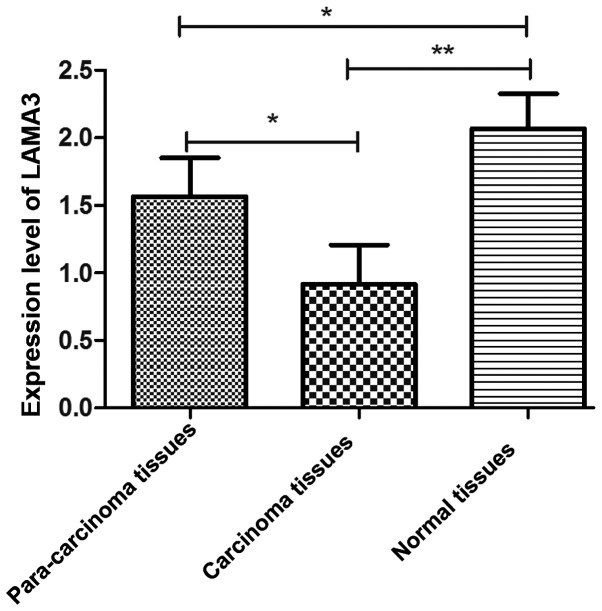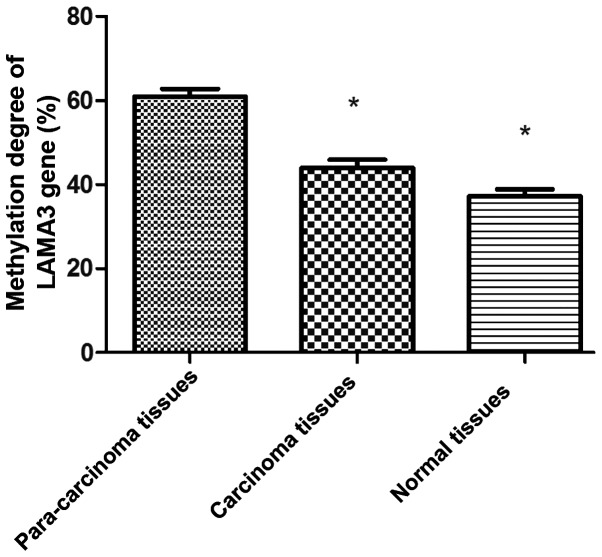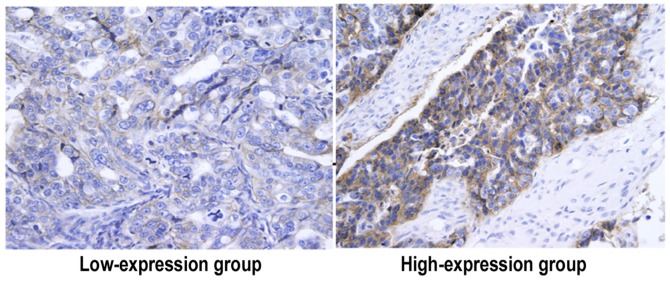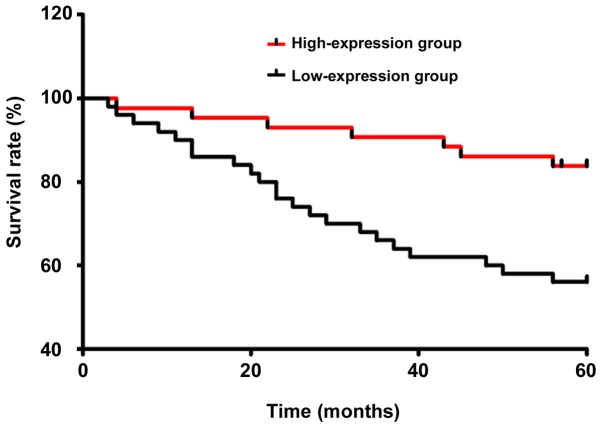Abstract
Correlation of laminin subunit α3 (LAMA3) gene with onset and prognosis of ovarian cancer was investigated. In total, 210 ovarian cancer patients who received surgical resection in West China Second Hospital from March 2011 to March 2013 were randomly selected, and another 160 non-ovarian cancer patients who needed ovariectomy were also selected. The relative expression of LAMA3 gene was compared via quantitative polymerase chain reaction (qPCR) in carcinoma tissues, para-carcinoma tissues and non-carcinoma normal tissues in ovarian cancer patients. The methylation level was compared among the above three tissue types. The correlation between the mutation site rs12373237 in LAMA3 gene and onset was analyzed. The expression of laminin in ovarian cancer was detected using immunohistochemistry. Moreover, the 5-year survival rate after operation was recorded and the survival curve was plotted. The expression level of LAMA3 was lower in carcinoma tissues than those in normal tissues and para-carcinoma tissues (P<0.05). The methylation degree was lower in para-carcinoma tissues and normal tissues than that in carcinoma tissues (P<0.05). The CC homozygous mutation of rs12373237 was highly correlated with the onset of ovarian cancer (OR=4.333, P=0.028). The expression of LAMA3 was classified via immunohistochemistry, and the number in high-expression group (63.8%) was larger than that in low-expression group (36.2%) (P<0.05). According to the analysis of 5-year survival rate, the recurrence-free survival rate and overall survival rate in LAMA3 high-expression group were significantly higher than those in LAMA3 low-expression group (P<0.05). The expression level and base mutation of LAMA3 gene can change the level of laminin, which have a certain influence on the onset and prognosis of ovarian cancer.
Keywords: LAMA3 gene, ovarian cancer, expression level, prognosis
Introduction
Ovarian cancer is one of the common gynecological tumors, whose incidence and mortality rates are fairly high among gynecological tumors (1). At present, studies have focused on genetic detection and targeted therapy worldwide. Some targeted drugs have satisfactory effects in treating ovarian cancer and prolonging life-span of patients (2,3).
It has been recently proven that laminin subunit α3 (LAMA3) plays an important role in the occurrence of various types of cancer that encode laminin. Moreover, LAMA3 is essential for the formation and function of basement membrane and plays an additional role in regulating cell migration and mechanical signal transduction (4). This gene encodes an α-subunit and can regulate keratinocyte growth factor, epidermal growth factor and insulin-like growth factor (5,6). Currently, research on this gene mostly focuses on gastric cancer, albeit some studies have focused on breast and prostate cancer (7). However, there are few studies on LAMA3 in ovarian cancer. In particular, the characteristics of this gene in the occurrence and development of lung cancer remain unclear (8,9).
In this study, the correlation of LAMA3 gene expression with the onset and prognosis of ovarian cancer was investigated in order to provide references for clinical diagnosis and treatment.
Patients and methods
Study subjects
A total of 210 ovarian cancer patients who received surgical resection in West China Second Hospital (Chengdu, China) from March 2011 to March 2013 were randomly selected. The patients were aged 48.34±12.43 years on average, including 65 patients in stage I, 43 patients in stage II, 53 patients in stage III and 49 patients in stage IV. Another 160 non-ovarian cancer patients who needed ovariectomy were also selected, and they were aged 49.76±13.45 years on average.
This study was approved by the Ethics Committee of West China Second Hospital, and patients and their families were informed of the study purpose and agreed and signed informed consent.
RNA extraction and qPCR
A comparison of LAMA3 gene expression among carcinoma tissues, para-carcinoma tissues and non-carcinoma normal tissues obtained from ovarian cancer patients was carried out via quantitative polymerase chain reaction (qPCR)
Ovarian cancer, para-carcinoma and non-carcinoma tissues were ground with liquid nitrogen, and ribonucleic acid (RNA) was extracted from samples using TRIzol in strict accordance with the protocol. One microgram RNA was taken and reverse transcribed into complementary deoxyribonucleic acid (cDNA) according to instructions of the reverse transcriptase kit. The concentration of cDNA was adjusted, followed by detection of the messenger RNA (mRNA) level using the CFX 96 PCR instrument (Bio-Rad Laboratories, Inc., Hercules, CA, USA) according to instructions of the SYBR® Premix Ex Taq™ II kit. Reaction conditions are as follows: 95°C for 2 min, 94°C for 15 sec, 50°C for 25 sec, a total of 40 cycles. The corresponding primer sequences are shown in Table I.
Table I.
Primer sequences.
| Gene name | Primer sequences |
|---|---|
| LAMA3 | F: 5′-ACCCAGGCCAAGGACCTGAGG-3′ |
| R: 5′-GTGTTGCCCGATTAACATTG-3′ | |
| β-actin | F: 5′-GTGGACATCCGCAAAGAC-3′ |
| R: 5′-GAAAGGGTGTAACGCAACTA-3′ |
F, forward; R, reverse. LAMA3, laminin subunit α3.
Methylation detection of tissue samples
Genomic DNA was extracted using the tissue DNA extraction kit (Tianjin Genetic Biotech, Beijing, China). The samples were added into the BDS Hypersil C18 column of high-performance liquid chromatographic instrument (Shimadzu, Kyoto, Japan) using the microsyringe, followed by elution under low temperature using a mixed solution of methanol, sodium pentanesulfonate and triethylamine as the mobile phase at a flow rate of 1 l/min, ultraviolet wavelength of 273 nm and sensitivity of 0.01 AUFS. The standard samples of deoxycytidine and deoxymethylcytosine were used as controls, and the DNA methylation content in samples was detected. It was measured for 3 times in each sample and the average was taken.
Single nucleotide polymorphism (SNP) typing of rs12373237 via multiple PCR
The primer sequences at the SNP site and its TaqMan probe sequences were designed using Oligo7.0 (Table II), and primers were synthesized by Sangon, Shanghai. One microliter DNA solution and 1.2 µl primer solution were prepared (including 0.4 µl forward primers, 0.4 µl reverse primers and 0.4 µlprobe primers) and added into the pre-prepared 17.8 µl TransStart Probe PCR SuperMix (Beijing TransGen Biotech Co., Ltd.) vibrated slightly, mixed evenly and placed into the CFX96 fluorescence quantitative PCR instrument (Bio-Rad Laboratories, Inc.). Three repeated wells were set for each sample, diethylpyrocarbonate (DEPC)-treated water was used as the negative control, and the positive plasmid containing this sequence (synthesized by Sangon, Shanghai, China) was used as the positive control. In terms of genotype determination, the genotype close to the abscissa was wild-type homozygote, which when close to ordinate was mutant-type homozygote, and when close to 45° line was heterozygote.
Table II.
rs12373237 primer sequences.
| SNP | Primer sequence | Probe sequence |
|---|---|---|
| rs12373237 | F: 5′-ATGATAGCGATTCTCCTCCTC-3′ | FAM: 5′-ACATAGGTCTACTTTTTTGG-3′ |
| R: 5′-AACAGGTCAGCGGGAACCTTG-3′ | VIC: 5′-ACATAGGTCCACTTTTTTGG-3′ |
F, forward; R, reverse. SNP, single nucleotide polymorphism.
Immunohistochemistry
Immunohistochemical detection of laminin expression was carried out as previously described (10). Criteria for positive cells in stained samples: i) There are brown yellow particles, and ii) the staining intensity is higher than that of non-specific staining in the field of view. The tumor cells and interstitial endothelial cells were observed and positioned. Five different fields of view (×400) were selected to observe each sample section. The relative expression level was: The number of positive cells >50% (3 points), 25–49% (2 points), 1–24% (1 point) and <1% (0 point). The staining intensity was: deep staining (3 points), moderate staining (2 points) and light staining (1 point). The two scores were added up as a basis of determining the expression level, and a total score ≤3 points indicated a low expression, while >3 points indicated high expression.
Statistics of 5-year survival status of patients via follow-up. Patients were followed up via telephone or visit every month, the recovery condition of patients was inquired, the number of recurrence and death was recorded, and the 5-year recurrence-free survival rate and overall survival rate were calculated.
Statistical analysis
The Statistical Product and Service Solutions (SPSS) 19.0 software was used for data processing. Measurement data were expressed as mean ± SD. The t-test and one-way analysis of variance and LSD post hoc test were used for the comparison of means. Chi-square test was used for enumeration data. Hardy Weinberg equilibrium law was used for genotype distribution analysis. Survival analysis was determined using the Kaplan-Meiersurvival curve and log-rank test. P<0.05 indicates that the difference was statistically significant.
Results
LAMA3 gene expression level in ovarian patients
Comparison of LAMA3 gene expression level among carcinoma tissues, para-carcinoma tissues and non-carcinoma normal tissues in ovarian cancer patients was carried out. The expression level of LAMA3 was lower in carcinoma tissues than those in normal and para-carcinoma tissues (P<0.05). Moreover, the expression level of LAMA3 was lower in para-carcinoma tissues than that in normal tissues (P<0.05) (Fig. 1).
Figure 1.
Relative expression level of LAMA3 gene detected via quantitative PCR. The expression level of LAMA3 is lower in carcinoma tissues than those in normal tissues and para-carcinoma tissues (*P<0.05). The expression level of LAMA3 is lower in para-carcinoma tissues than that in normal tissues (*P<0.05). LAMA3, laminin subunit α3. **P<0.01.
Comparison of methylation degree of LAMA3 gene
The methylation degree was lower in carcinoma tissues and normal tissues than that in para-carcinoma tissues (P<0.05) (Fig. 2).
Figure 2.
Comparison of methylation degree of LAMA3 gene. The methylation degree is lower in carcinoma tissues and normal tissues than that in para-carcinoma tissues (*P<0.05). LAMA3, laminin subunit α3.
Correlation between LAMA3 gene polymorphism and onset of ovarian cancer
In ovarian cancer patients, the distribution frequency of TT and TC genotypes of rs12373237 had no statistically significant differences compared with that in control group (P>0.05), but there was a statistically significant difference in the CC genotype (P<0.05) (Table III). The genotype distribution in both groups met the Hardy-Weinberg equilibrium law (Pcontrol =0.31, Pobservation =0.35). The odds ratio (OR) was 1.195 in the dominant model (TC+CC/TT) (P=0.532), and 4.333 in the recessive model (CC/TT+TC) (P=0.028). In the co-dominant model, the OR was 0.967 in TC/TT and 4.43 in CC/TT (P=0.09) (Table IV).
Table III.
Distribution frequency of rs12373237 (n, %).
| Observation group (n=210) | Control group (n=160) | |||||
|---|---|---|---|---|---|---|
| Genotype | N | % | N | % | χ2 test | P-value |
| TT | 125 | 59.5 | 102 | 63.8 | 0.391 | 0.532 |
| TC | 64 | 30.5 | 54 | 33.7 | 0.235 | 0.628 |
| CC | 21 | 10 | 4 | 2.5 | 4.8 | 0.028 |
| T | 314 | 74.8 | 258 | 80.6 | 0.971 | 0.324 |
| C | 106 | 25.2 | 62 | 19.4 | ||
Table IV.
Disease risks in different models.
| Model | Genotype | Observation group (n=210) | Control group (n=160) | OR (95% CI) | P-value |
|---|---|---|---|---|---|
| Dominant model | TT | 125 | 102 | 1 | 0.532 |
| TC+CC | 85 | 58 | 1.195 (0.732–1.532) | ||
| Recessive model | TT+TC | 189 | 156 | 1 | 0.028 |
| CC | 21 | 4 | 4.333 (2.321–7.786) | ||
| Co-dominant model | TT | 125 | 102 | 1 | 0.09 |
| TC | 64 | 54 | 0.967 (0.657–1.214) | ||
| CC | 21 | 4 | 4.43 (2.451–7.698) |
Expression of laminin
According to the immunohistochemical detection, there were 134 cases (63.8%) in high-expression group, which was more than that in low-expression group (76 cases, 36.2%) (P<0.05) (Fig. 3).
Figure 3.
Immunohistochemical detection results of laminin in ovarian tissues.
Five-year survival curve
According to the analysis of 5-year survival rate, the recurrence-free survival rate and overall survival rate in LAMA3 high-expression group were significantly higher than those in LAMA3 low-expression group (P<0.05) (Table V). The Kaplan-Meier survival curves and log-rank test in both groups are shown in Fig. 4.
Table V.
Comparison of survival rate between low-expression group and high-expression group [n (%)].
| Group | n | Recurrence-free survival rate | Overall survival rate |
|---|---|---|---|
| High-expression group | 134 | 91 (67.9) | 116 (86.6) |
| Low-expression group | 76 | 27 (35.5) | 44 (57.9) |
| χ2 test | 13.92 | 39.84 | |
| P-value | <0.001 | <0.001 |
Figure 4.
Kaplan-Meier survival curve and log-rank test. The 5-year survival rate in high-expression group is higher than that in low-expression group (P<0.05).
Discussion
At present, with the development of molecular diagnosis and individualized treatment technique for tumors, the research emphasis of ovarian cancer, one of the frequently-occurring gynecological tumors, has been gradually transferred to the gene and molecular levels (11,12). The pathogenesis of ovarian cancer is complex, and the external environmental stimulus, gene damage and emergence of tumor stem cells are important theories of its onset (13,14). Surgical resection is the most effective therapeutic method for ovarian cancer currently, which, however, will lead to various sequelae, such as obesity, hypertension, heart disease and osteoporosis (15). In terms of drug therapy, chemotherapeutic drugs applied clinically are harmful to the body's immune system, and the emerging cell therapy has obtained a certain effect only in in vitro experiments and animal experiments, but its anti-solid tumor effect in the human body is still unsatisfactory (16,17). Therefore, studying the pathogenesis to clarify the correlation between gene and onset is of great significance in the prevention of disease and development of targeted drugs.
LAMA3 encodes laminin and widely exists in each organ of human, which can regulate cell attachment and migration during embryonic development through interaction with other extracellular matrix components and binding to cells via high-affinity receptor, thus indirectly promoting and inhibition of the growth of tumor cells (18). Studies have found that the expression level of LAMA3 is related to the occurrence of gastric cancer, and its high expression can inhibit the occurrence of gastric cancer (19). In this study, it was also found that the expression level of LAMA3 in ovarian cancer was lower than those in para-carcinoma tissues and non-carcinoma tissues, which was similar to the research report on gastric cancer. Svoboda et al (20) also analyzed the liver cancer tissues and surrounding normal tissues using the C-DNA microarray and RT-PCR, and found that the expression of LAMA3 gene is upregulated in liver cancer tissues, indicating that the expression of LAMA3 gene has a consistent correlation with a variety of cancers, including ovarian cancer, and they share a common signaling pathway in molecular mechanism.
It was also found in this study that the methylation degree was lower in para-carcinoma tissues and normal tissues than that in carcinoma tissues, suggesting that the higher the methylation degree is, the higher the probability of ovarian cancer will be. Shukla et al (21) found that LAMA3 is expressed in benign breast tissues and deleted in breast cancer tissues, and the LAMA3 gene expression in breast cancer cell lines is restored after demethylation, indicating that methylation may be a mechanism of expression silencing of LAMA3 gene. According to the gene polymorphism study, it has been proved that the base structure and number of the same gene are different in different people, and such a difference will lead to changes in the translation level, thereby affecting the physical development and metabolism related to the gene. Rs12373237 is a point mutation in the intron of LAMA3 gene, and it has been reported that its site mutation is certainly related to the cardiovascular and cerebrovascular diseases and chronic renal diseases. This study showed that the CC homozygous mutation of rs12373237 had a high correlation with the onset of ovarian cancer. The analysis suggests that the CC mutation may reduce the expression level of LAMA3 gene and the production amount of laminin.
In this study, the 5-year recurrence-free survival rate and overall survival rate of the patients were compared, and it was found that both rates in LAMA3 high-expression group were significantly higher than those in low-expression group, indicating that the expression level of LAMA3 gene also affects the postoperative recovery and therapeutic effect.
In conclusion, the expression level and base mutation of LAMA3 gene can change the level of laminin, which have a certain influence on the onset and prognosis of ovarian cancer.
Acknowledgements
Not applicable.
Funding
No funding was received.
Availability of data and materials
The datasets used and/or analyzed during the current study are available from the corresponding author on reasonable request.
Authors' contributions
LT and PW were responsible for PCR and methylation detection of tissue samples. QW and LZ collected and analyzed general data of patients. LT wrote the manuscript. LZ helped with follow-up analysis. All authors read and approved the final manuscript.
Ethics approval and consent to participate
The study was approved by the Ethics Committee of West China Second Hospital (Chengdu, China) and informed consents were signed by the patients or the guardians.
Patient consent for publication
Not applicable.
Competing interests
The authors declare that they have no competing interests.
References
- 1.Xu Y, Cheng L, Dai H, Zhang R, Wang M, Shi T, Sun M, Cheng X, Wei Q. Variants in Notch signalling pathway genes, PSEN1 and MAML2, predict overall survival in Chinese patients with epithelial ovarian cancer. J Cell Mol Med. 2018;22:4975–4984. doi: 10.1111/jcmm.13764. [DOI] [PMC free article] [PubMed] [Google Scholar]
- 2.Oliveira-Ferrer L, Goswami R, Galatenko V, Ding Y, Eylmann K, Legler K, Kürti S, Schmalfeldt B, Milde-Langosch K. Prognostic impact of CEACAM1 in node-negative ovarian cancer patients. Dis Markers. 2018;2018:6714287. doi: 10.1155/2018/6714287. [DOI] [PMC free article] [PubMed] [Google Scholar]
- 3.Rhyasen GW, Yao Y, Zhang J, Dulak A, Castriotta L, Jacques K, Zhao W, Gharahdaghi F, Hattersley MM, Lyne PD, et al. BRD4 amplification facilitates an oncogenic gene expression program in high-grade serous ovarian cancer and confers sensitivity to BET inhibitors. PLoS One. 2018;13:e0200826. doi: 10.1371/journal.pone.0200826. [DOI] [PMC free article] [PubMed] [Google Scholar]
- 4.Castro BG, Dos Reis R, Cintra GF, Sousa MM, Vieira MA, Andrade CE. Predictive factors for surgical morbidities and adjuvant chemotherapy delay for advanced ovarian cancer patients treated by primary debulking surgery or interval debulking surgery. Int J Gynecol Cancer. 2018;28:1520–1528. doi: 10.1097/IGC.0000000000001325. [DOI] [PubMed] [Google Scholar]
- 5.Saxena P, Severi L, Santucci M, Taddia L, Ferrari S, Luciani R, Marverti G, Marraccini C, Tondi D, Mor M, et al. Conformational propensity and biological studies of proline mutated LR peptides inhibiting human thymidylate synthase and ovarian cancer cell growth. J Med Chem. 2018;61:7374–7380. doi: 10.1021/acs.jmedchem.7b01699. [DOI] [PubMed] [Google Scholar]
- 6.Shu C, Yan D, Mo Y, Gu J, Shah N, He J. Long noncoding RNA lncARSR promotes epithelial ovarian cancer cell proliferation and invasion by association with HuR and miR-200 family. Am J Cancer Res. 2018;8:981–992. [PMC free article] [PubMed] [Google Scholar]
- 7.Coogan PF, Rosenberg L, Palmer JR, Strom BL, Zauber AG, Shapiro S. Statin use and the risk of breast and prostate cancer. Epidemiology. 2002;13:262–267. doi: 10.1097/00001648-200205000-00005. [DOI] [PubMed] [Google Scholar]
- 8.Chen P, Fang X, Xia B, Zhao Y, Li Q, Wu X. Long noncoding RNA LINC00152 promotes cell proliferation through competitively binding endogenous miR-125b with MCL-1 by regulating mitochondrial apoptosis pathways in ovarian cancer. Cancer Med. 2018;7:4530–4541. doi: 10.1002/cam4.1547. [DOI] [PMC free article] [PubMed] [Google Scholar]
- 9.Hong SS, Zhang MX, Zhang M, Yu Y, Chen J, Zhang XY, Xu CJ. Follicle-stimulating hormone peptide-conjugated nanoparticles for targeted shRNA delivery lead to effective gro-α silencing and antitumor activity against ovarian cancer. Drug Deliv. 2018;25:576–584. doi: 10.1080/10717544.2018.1440667. [DOI] [PMC free article] [PubMed] [Google Scholar]
- 10.Ahmad F, Shah K, Umair M, Irfanullah JA, Khan S, Muhammad D, Basit S, Wakil SM, Ramzan K, et al. Novel autosomal recessive LAMA3 and PLEC variants underlie junctional epidermolysis bullosa generalized intermediate and epidermolysis bullosa simplex with muscular dystrophy in two consanguineous families. Clin Exp Dermatol. 2018;43:752–755. doi: 10.1111/ced.13610. [DOI] [PubMed] [Google Scholar]
- 11.Zhang J, Wang H, Wang Y, Dong W, Jiang Z, Yang G. Substrate-mediated gene transduction of LAMA3 for promoting biological sealing between titanium surface and gingival epithelium. Colloids Surf B Biointerfaces. 2018;161:314–323. doi: 10.1016/j.colsurfb.2017.10.030. [DOI] [PubMed] [Google Scholar]
- 12.Reimer A, Schwieger-Briel A, He Y, Leppert J, Schauer F, Kiritsi D, Schneider H, Ott H, Bruckner-Tuderman L, Has C. Natural history and clinical outcome of junctional epidermolysis bullosa generalized intermediate due to a LAMA3 mutation. Br J Dermatol. 2018;178:973–975. doi: 10.1111/bjd.16088. [DOI] [PubMed] [Google Scholar]
- 13.Gostyńska KB, Yan Yuen W, Pasmooij AM, Stellingsma C, Pas HH, Lemmink H, Jonkman MF. Carriers with functional null mutations in LAMA3 have localized enamel abnormalities due to haploinsufficiency. Eur J Hum Genet. 2016;25:94–99. doi: 10.1038/ejhg.2016.136. [DOI] [PMC free article] [PubMed] [Google Scholar]
- 14.Pesch M, König S, Aumailley M. Targeted disruption of the Lama3 gene in adult mice is sufficient to induce skin inflammation and fibrosis. J Invest Dermatol. 2017;137:332–340. doi: 10.1016/j.jid.2016.07.040. [DOI] [PubMed] [Google Scholar]
- 15.Arora E, Masab M, Jindal V, Riaz I, Gupta S, Varadi G. Role of poly adenosine diphosphate ribose polymerase inhibitors in advanced stage ovarian cancer. Cureus. 2018;10:e2685. doi: 10.7759/cureus.2685. [DOI] [PMC free article] [PubMed] [Google Scholar]
- 16.Srinivas KG, Mirza AA, Swamy S, Amarendra S, Kodaganur G. Metachronous synchronous sternal and colonic metastasis with asymptomatic colo-colic fistula from carcinoma ovary rare presentation of ovarian cancer. Indian J Surg Oncol. 2017;8:615–618. doi: 10.1007/s13193-016-0576-3. [DOI] [PMC free article] [PubMed] [Google Scholar]
- 17.Stone ML, Chiappinelli KB, Li H, Murphy LM, Travers ME, Topper MJ, Mathios D, Lim M, Shih IM, Wang TL, et al. Epigenetic therapy activates type I interferon signaling in murine ovarian cancer to reduce immunosuppression and tumor burden. Proc Natl Acad Sci USA. 2017;114:E10981–E10990. doi: 10.1073/pnas.1712514114. [DOI] [PMC free article] [PubMed] [Google Scholar]
- 18.Stemmler S, Parwez Q, Petrasch-Parwez E, Epplen JT, Hoffjan S. Association of variation in the LAMA3 gene, encoding the alpha-chain of laminin 5, with atopic dermatitis in a German case-control cohort. BMC Dermatol. 2014;14:17. doi: 10.1186/1471-5945-14-17. [DOI] [PMC free article] [PubMed] [Google Scholar]
- 19.Lincoln V, Cogan J, Hou Y, Hirsch M, Hao M, Alexeev V, De Luca M, De Rosa L, Bauer JW, Woodley DT, et al. Gentamicin induces LAMB3 nonsense mutation readthrough and restores functional laminin 332 in junctional epidermolysis bullosa. Proc Natl Acad Sci USA. 2018;115:E6536–E6545. doi: 10.1073/pnas.1803154115. [DOI] [PMC free article] [PubMed] [Google Scholar]
- 20.Svoboda M, Hlobilová M, Marešová M, Sochorová M, Kováčik A, Vávrová K, Dolečková I. Comparison of suction blistering and tape stripping for analysis of epidermal genes, proteins and lipids. Arch Dermatol Res. 2017;309:757–765. doi: 10.1007/s00403-017-1776-6. [DOI] [PubMed] [Google Scholar]
- 21.Shukla DK, Gupta D, Aggarwal A, Kumar D. A case report of newly diagnosed epithelial ovarian carcinoma presenting with spontaneous tumor lysis syndrome and its successful management with rasburicase. Indian J Med Paediatr Oncol. 2017;38:360–362. doi: 10.4103/ijmpo.ijmpo_23_16. [DOI] [PMC free article] [PubMed] [Google Scholar]
Associated Data
This section collects any data citations, data availability statements, or supplementary materials included in this article.
Data Availability Statement
The datasets used and/or analyzed during the current study are available from the corresponding author on reasonable request.






